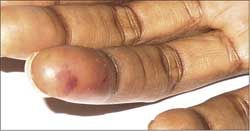- Clinical Technology
- Adult Immunization
- Hepatology
- Pediatric Immunization
- Screening
- Psychiatry
- Allergy
- Women's Health
- Cardiology
- Pediatrics
- Dermatology
- Endocrinology
- Pain Management
- Gastroenterology
- Infectious Disease
- Obesity Medicine
- Rheumatology
- Nephrology
- Neurology
- Pulmonology
Osler Nodes
Osler nodes may accompany bacteremia without endocarditis, septic endarteritis, typhoid fever, gonococcemia, systemic lupus erythematosus, and nonbacterial thrombotic endocarditis.
For 4 months, a 41-year-old woman had pain in the pulp of her fingers and dorsa of her feet that was associated with transient maculopapular lesions at different sites. During this period, she had been hospitalized twice for the same complaint. Findings from an extensive rheumatological workup were negative. She also had an unintentional 20-lb weight loss.
On examination, a purplish red maculopapular lesion was noted on the pulp of her finger and was identified as an Osler node. She did not have a heart murmur. Physical findings were otherwise normal. Blood cultures grew Enterococcus faecalis, and intravenous antibiotic therapy was started. Transesophageal echocardiography showed large, highly mobile vegetations on both leaflets of the mitral valve. The patient’s functional status improved with long-term antibiotic therapy.

Osler nodes are small, usually raised, purplish red lesions, which are always tender, appear suddenly, and last 4 to 5 days. Painful fingers may be the earliest complaint or the chief complaint,1 as with this patient. The nodes can appear on the dorsa of the feet (which this patient reported) and elsewhere.2 Osler nodes sometimes also accompany bacteremia without endocarditis as well as septic endarteritis, typhoid fever, gonococcemia, systemic lupus erythematosus, and nonbacterial thrombotic endocarditis.3
The pathophysiological origin of Osler nodes remains obscure more than a century after the original description of this entity.4 It is now believed that microemboli account for Osler nodes and elicit a secondary vasculitis through immune-mediated mechanisms.
References:
REFERENCES:
1.
Yee J, McAllister CK. Osler’s nodes and the recognition of infective endocarditis: a lesion of diagnostic importance.
South Med J.
1987;80:753-757.
2.
Watanakunakorn C. Osler’s nodes on the dorsum of the foot.
Chest.
1988;94: 1088-1090.
3.
Freedberg IM, Eisen AZ, Wolff K, et al, eds.
Fitzpatrick’s Dermatology in General Medicine.
7th ed. New York: McGraw-Hill; 2008:1453.
4.
Alpert JS, Krous HF, Dalen JE, et al. Pathogenesis of Osler’s nodes.
Ann Intern Med.
1976;85:471-473.
